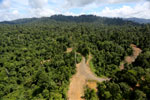While conducting field research in the humid salt marshes of Sapelo Island, scientists Marc Hensel and Brian Silliman made an astonishing discovery: species type, not just quantity, is vital for maintaining healthy ecosystems. For decades, scientists believed that preserving the largest number of species was critical for ecosystem function, regardless of their genetic makeup. However, Hensel, a PhD student at the University of Massachusetts at Boston, and Silliman, Rachel Carson Associate Professor at Duke University, counter the old dogma in an article recently published in Proceedings of the National Academy of Sciences.
 Marsh periwinkle. Photo by Mary Hollinger, NESDIS/NODC biologist, NOAA under a Creative Commons Attribution 2.0 Generic license.
Marsh periwinkle. Photo by Mary Hollinger, NESDIS/NODC biologist, NOAA under a Creative Commons Attribution 2.0 Generic license.
“It’s quality, not just quantity,” stated Hensel. “We need to preserve a wide variety of species.”
By examining the relationships among three dominant consumer species (i.e., grazers and predators), Hensel and Silliamn found that it isn’t just the number of total species, but the number of specific species that is crucial to upholding ecosystem performance. Working in the cordgrass (Spartina alterniflora) dominated salt marshes of Sapelo Island in the Southeastern U.S. state of Georgia, the researchers measured the effect of species loss on ecosystem performance. Salt marshes are seemingly simple ecosystems composed of a few extremely abundant and influential species.
 A photo of the research site with different experimental treatments in the cordgrass Spartina alterniflora dominated salt marsh on Sapelo Island. Photo credit: Marc Hensel |
The research team created eight different experimental plots that simulated the loss of three dominant groups: purple marsh crab (Sesarma reticulatum), marsh periwinkle snail (Litoraria irrorata), and fungi (Mycosphaerella species and Phaeospheria spartinicola). Each of the three evolutionarily distinct species plays a critical role in regulating marsh functions and maintaining habitat structure. Over a period of eight months, the researchers assessed the impact of the loss of these species on ecosystem functions by measuring the rates of grass growth, decomposition and filtration of tidal or storm water.
 The cordgrass grazing purple marsh crab (Sesarma reticulatum) of Sapelo Island. Photo credit: Marc Hensel. |
Hensel and Silliman found that although each species influenced just one or two specific ecosystem functions, the overall performance of marsh functions dropped considerably when one or more of the consumers were removed. Furthermore, the presence of very different groups was essential for providing a realistic assessment of marsh functions, particularly the inclusion of fungal species.
Fungus is not only a dominant group in the Sapelo Island salt marsh, but microbes such as fungal spores are key components of the food web and considered fundamental underpinnings of ecosystem functions. Therefore, by including fungus, Hensel and Silliman gained a deeper, more complete understanding of the marsh ecosystem functions and services.
Salt marshes provide coastal communities with essential services such as buffering waves, filtering urban water runoff, and providing nursery habitat for commercially valuable juvenile aquatic species. But when key species were removed from the salt marshes, the ecosystem was not able to function properly, thus limiting the performance of these services.
“We found that variety is the spice of life in salt marshes,” Hensel told mongabay.com, “Salt marshes are a very important ecosystem to humans (hurricane Sandy has recently reminded us of that) and here we found something that should affect the way the public and managers think about marshes: if you want a marsh to do a lot of things (sequester carbon, filter pollution, house many young fish, crabs, and shrimp, protect houses on the coast), you need to have different species.”
Hensel hopes these new findings will provide a different way to think about conservation and restoration as well as encourage other researchers to consider looking at evolutionarily distinct species and measuring the performance of multiple ecosystem functions.
Citations:
- “Consumer Diversity across Kingdoms Supports Multiple Functions in a Coastal Ecosystem” Marc J. S. Hensel and Brian R. Silliman. Proceedings of the National Academy of Sciences, Dec. 4, 2013. online.
Related articles
Next big idea in forest conservation? Integrating forest conservation, use, and restoration

(01/10/2014) The next big idea is to integrate the social and natural components of forest conservation, use of forest products, and restoration. In reality, these aspects are completely intertwined, but in practice they are completely separated. I believe (along with many others) that the scale at which we can begin to integrate these components is at the landscape scale.
Over 75 percent of large predators declining

(01/09/2014) The world’s top carnivores are in big trouble: this is the take-away message from a new review paper published today in Science. Looking at 31 large-bodied carnivore species (i.e those over 15 kilograms or 33 pounds), the researchers found that 77 percent are in decline and more than half have seen their historical ranges decline by over 50 percent. In fact, the major study comes just days after new research found that the genetically-unique West African lion is down to just 250 breeding adults.
Rainforest news review for 2013

(12/26/2013) 2013 was full of major developments in efforts to understand and protect the world’s tropical rainforests. The following is a review of some of the major tropical forest-related news stories for the year. As a review, this post will not cover everything that transpired during 2013 in the world of tropical forests. Please feel free to highlight anything this post missed via the comments section at the bottom. Also please note that this review focuses only on tropical forests.
Tiny algae signal big changes for warming Arctic lakes

(11/15/2013) The mighty polar bear has long been the poster child for the effects of global warming in the Arctic, but the microscopic diatom tells an equally powerful story. Diatoms are a type of algae that form the base of the food chain in watery habitats the world over. Disturbances among lake diatoms have exposed the impacts of rapid warming in the Hudson Bay Lowlands of eastern Canada, researchers reported Oct. 9 in the Proceedings of the Royal Society B
Coelacanths might be monogamous, to the surprise of researchers

(11/14/2013) They evaded humans for millions of years and live very private lives. The hulking, fleshy-finned fish known as the coelacanth has beguiled scientists for generations. But the coelacanth mystique that enchants researchers also makes it difficult to study. Researchers recently revealed in Nature Communications one startling aspect of the coelacanth lifestyle: they might be monogamous.
Wolves boost food for Yellowstone’s threatened grizzlies

(11/13/2013) Wolves and grizzlies aren’t best buddies. Burly bears can barge in on a feasting pack, making off with the wolves’ fresh kill. Wolves have been known to dig into bear dens and snag a cub. But after gray wolves returned to Yellowstone National Park in 1995, grizzly bears ate more berries in the summer for a pre-hibernation nutritional boost, researchers reported Sept. 4 in the Journal of Animal Ecology